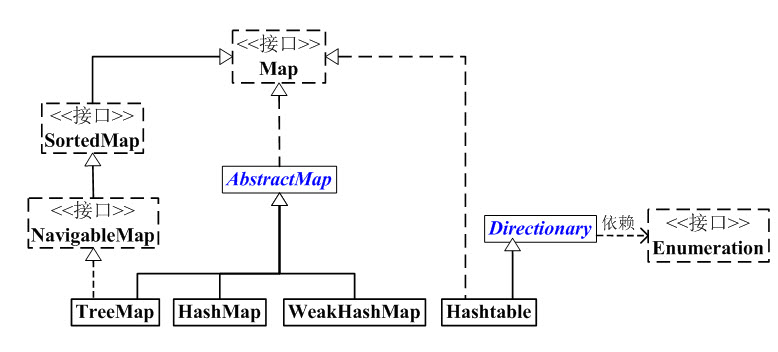您好,登錄后才能下訂單哦!
您好,登錄后才能下訂單哦!
本篇內容主要講解“Map的介紹的使用方法”,感興趣的朋友不妨來看看。本文介紹的方法操作簡單快捷,實用性強。下面就讓小編來帶大家學習“Map的介紹的使用方法”吧!

Map是一個映射接口,不同于List和Set的是他不繼承于Collection接口,Map中存儲的內容是鍵值對(key-value)。
AbstractMap 是繼承于Map的抽象類,它實現了Map中的大部分API。其它Map的實現類可以通過繼承AbstractMap來減少重復編碼。
SortedMap 是繼承于Map的接口。SortedMap中的內容是排序的鍵值對,排序的方法是通過比較器(Comparator)。
NavigableMap 是繼承于SortedMap的接口。相比于SortedMap,NavigableMap有一系列的導航方法;如"獲取大于/等于某對象的鍵值對"、“獲取小于/等于某對象的鍵值對”等等。
Map的主要實現類是HashMap、LinkedHashMap、TreeMap、HashTable等。
繼承于AbstractMap
保存無序的鍵值對
非線程安全,元素可為null
繼承于HashMap
保存有序的鍵值對,默認提供插入時的順序,也可構造成訪問順序。
非線程安全,元素不可為null
繼承于AbstractMap,且實現了NavigableMap接口
保存有序的鍵值對,默認對key排序,也可構造自定義的排序。
非線程安全,元素不可為null
但它繼承于Dictionary,而且也實現Map接口
保存無序的鍵值對
線程安全,元素可為null
interface Entry<K,V> {
K getKey();
V getValue();
V setValue(V value);
boolean equals(Object o);
int hashCode();
public static <K extends Comparable<? super K>, V> Comparator<Map.Entry<K,V>> comparingByKey() {
return (Comparator<Map.Entry<K, V>> & Serializable)
(c1, c2) -> c1.getKey().compareTo(c2.getKey());
}
public static <K, V extends Comparable<? super V>> Comparator<Map.Entry<K,V>> comparingByValue() {
return (Comparator<Map.Entry<K, V>> & Serializable)
(c1, c2) -> c1.getValue().compareTo(c2.getValue());
}
public static <K, V> Comparator<Map.Entry<K, V>> comparingByKey(Comparator<? super K> cmp) {
Objects.requireNonNull(cmp);
return (Comparator<Map.Entry<K, V>> & Serializable)
(c1, c2) -> cmp.compare(c1.getKey(), c2.getKey());
}
public static <K, V> Comparator<Map.Entry<K, V>> comparingByValue(Comparator<? super V> cmp) {
Objects.requireNonNull(cmp);
return (Comparator<Map.Entry<K, V>> & Serializable)
(c1, c2) -> cmp.compare(c1.getValue(), c2.getValue());
}
}/** 返回當前Map中鍵值對的數量 **/ int size(); /** 返回當前Map是否為空 **/ boolean isEmpty(); /** 返回當前Map是否包含鍵key **/ boolean containsKey(Object key); /** 返回當前Map是否包含值value **/ boolean containsValue(Object value); /** 返回當前Map中鍵key對應的值value **/ V get(Object key); /** 將當前Map中鍵key對應的值設置為value **/ V put(K key, V value); /** 移除當前Map中鍵key對應的值 **/ V remove(Object key); /** 將m中所有鍵值對放到當前Map中 **/ void putAll(Map<? extends K, ? extends V> m); /** 移除Map中所有鍵值對 **/ void clear(); /** 返回Map中key的集合 **/ Set<K> keySet(); /** 返回Map中value的集合 **/ Collection<V> values(); /** 返回Map中key-value的集合 **/ Set<Map.Entry<K, V>> entrySet();
/** 根據key獲取value 如果value為空返回默認值defaultValue **/
default V getOrDefault(Object key, V defaultValue) {
V v;
return (((v = get(key)) != null) || containsKey(key)) ? v : defaultValue;
}
/** 函數式編程 遍歷map中鍵值對 **/
default void forEach(BiConsumer<? super K, ? super V> action) {
Objects.requireNonNull(action);
for (Map.Entry<K, V> entry : entrySet()) {
K k;
V v;
try {
k = entry.getKey();
v = entry.getValue();
} catch(IllegalStateException ise) {
// this usually means the entry is no longer in the map.
throw new ConcurrentModificationException(ise);
}
action.accept(k, v);
}
}
/** 函數式編程 提供一個方法 替換所有的value **/
default void replaceAll(BiFunction<? super K, ? super V, ? extends V> function) {
Objects.requireNonNull(function);
for (Map.Entry<K, V> entry : entrySet()) {
K k;
V v;
try {
k = entry.getKey();
v = entry.getValue();
} catch(IllegalStateException ise) {
// this usually means the entry is no longer in the map.
throw new ConcurrentModificationException(ise);
}
// ise thrown from function is not a cme.
v = function.apply(k, v);
try {
entry.setValue(v);
} catch(IllegalStateException ise) {
// this usually means the entry is no longer in the map.
throw new ConcurrentModificationException(ise);
}
}
}
/** 如果map中key為空 則往map中放入key-value **/
default V putIfAbsent(K key, V value) {
V v = get(key);
if (v == null) {
v = put(key, value);
}
return v;
}
/** 如果Map中的key對應的值是value 則移除此鍵值對 否則返回false **/
default boolean remove(Object key, Object value) {
Object curValue = get(key);
if (!Objects.equals(curValue, value) ||
(curValue == null && !containsKey(key))) {
return false;
}
remove(key);
return true;
}
/** 如果Map中的key對應的值是oldValue 則用newValue替換oldValue 否則返回false **/
default boolean replace(K key, V oldValue, V newValue) {
Object curValue = get(key);
if (!Objects.equals(curValue, oldValue) ||
(curValue == null && !containsKey(key))) {
return false;
}
put(key, newValue);
return true;
}
/** 如果Map中存在key鍵 則替換為value 否則返回false **/
default V replace(K key, V value) {
V curValue;
if (((curValue = get(key)) != null) || containsKey(key)) {
curValue = put(key, value);
}
return curValue;
}
/** 如果Map中key對應的value為空 則將key計算后設置為key對應的value **/
default V computeIfAbsent(K key,
Function<? super K, ? extends V> mappingFunction) {
Objects.requireNonNull(mappingFunction);
V v;
if ((v = get(key)) == null) {
V newValue;
if ((newValue = mappingFunction.apply(key)) != null) {
put(key, newValue);
return newValue;
}
}
return v;
}
/** 如果Map中 key對應的oldValue為空 則返回null
* 否則根據key和oldValue計算出新的newValue 如果newValue不為空則put到Map中 如果為空 則移除此鍵值對 **/
default V computeIfPresent(K key,
BiFunction<? super K, ? super V, ? extends V> remappingFunction) {
Objects.requireNonNull(remappingFunction);
V oldValue;
if ((oldValue = get(key)) != null) {
V newValue = remappingFunction.apply(key, oldValue);
if (newValue != null) {
put(key, newValue);
return newValue;
} else {
remove(key);
return null;
}
} else {
return null;
}
}
/** 根據Map中的key和對應的oldValue計算出newValue
* 如果newValue為空 且oldValue不為空 則移除此鍵值對
* 如果newValue為空 且oldValue為空且不存在key 返回null
* 如果newValue不為空 則put到Map中 **/
default V compute(K key,
BiFunction<? super K, ? super V, ? extends V> remappingFunction) {
Objects.requireNonNull(remappingFunction);
V oldValue = get(key);
V newValue = remappingFunction.apply(key, oldValue);
if (newValue == null) {
// delete mapping
if (oldValue != null || containsKey(key)) {
// something to remove
remove(key);
return null;
} else {
// nothing to do. Leave things as they were.
return null;
}
} else {
// add or replace old mapping
put(key, newValue);
return newValue;
}
}
/** 根據Map中的key查找oldValue 如果oldValue為空 則設置newValue為oldValue 否則根據oldValue和value計算出newValue
* 如果newValue為空 則移除此鍵值對 否則設置key的值為newValue **/
default V merge(K key, V value,
BiFunction<? super V, ? super V, ? extends V> remappingFunction) {
Objects.requireNonNull(remappingFunction);
Objects.requireNonNull(value);
V oldValue = get(key);
V newValue = (oldValue == null) ? value :
remappingFunction.apply(oldValue, value);
if(newValue == null) {
remove(key);
} else {
put(key, newValue);
}
return newValue;
}到此,相信大家對“Map的介紹的使用方法”有了更深的了解,不妨來實際操作一番吧!這里是億速云網站,更多相關內容可以進入相關頻道進行查詢,關注我們,繼續學習!
免責聲明:本站發布的內容(圖片、視頻和文字)以原創、轉載和分享為主,文章觀點不代表本網站立場,如果涉及侵權請聯系站長郵箱:is@yisu.com進行舉報,并提供相關證據,一經查實,將立刻刪除涉嫌侵權內容。